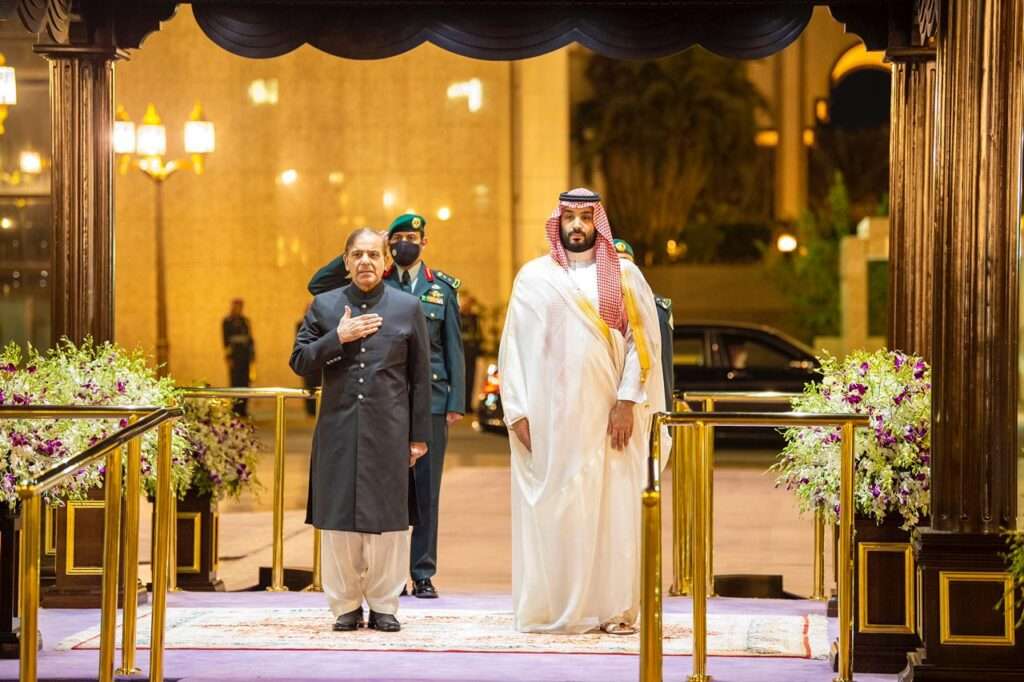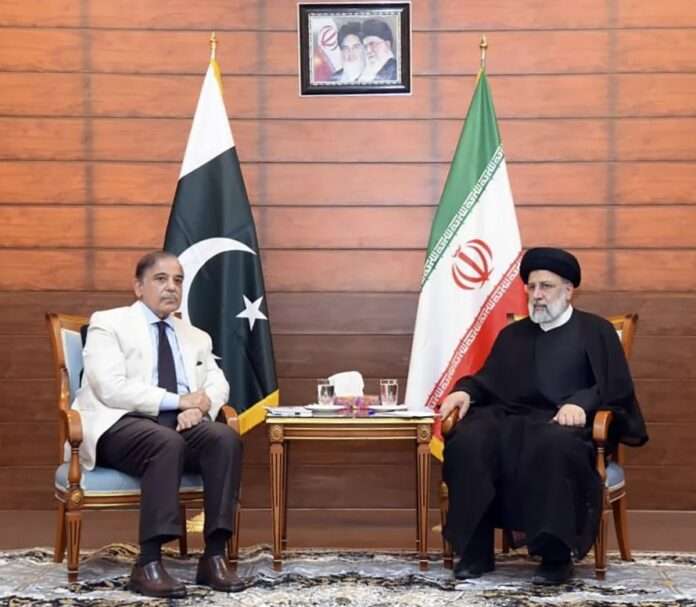The top leadership of Pakistan and Iran met on Thursday May 18th, 2023 and inaugurated the first border market as relations warm between the two countries. This border market is located in the remote village of Pashin in Pakistan’s Balochistan province; this marketplace is the first of six to be constructed along the Pakistan-Iran border under a 2012 agreement signed by both governments. Pakistani Prime Minister Shahbaz Sharif and Iranian President Ebrahim Raisi also inaugurated an electricity transmission line which will provide some of Pakistan’s remote regions with Iranian electricity. Both sides assured they would do their best to improve security along the Pak-Iranian border and both also agreed to enhance trade and economic ties.
Pakistan has warm and very close ties with Saudi Arabia, but has always tried to maintain a balanced relationship with Riyadh and Tehran, long-time rivals, restored ties earlier this year in a Chinese-brokered agreement. The restoration of Saudi-Iranian ties is a huge regional development that shocked the international power diplomacy.
Saudi Arabia is trying to diversify its external relations and responding to strategic paradigm shift by pivoting to Asia (China and Pakistan). Sufficient to say, under the circumstances, a China-Pakistan-Saudi axis has the potential to expand greatly. The common benefits are trade, connectivity and geo-politics. Most likely UAE will also follow, investing in CPEC after observing the Saudi strategic move at Gwadar. The recent visit of UAE Crown Prince Sheikh Mohammad Bin Zaid Al- Nahyan to Pakistan was of course a significant signal in this regard. The addition of Iran in this landscape would further enhance the viability of the regional economic development.
The Saudi Crown Prince’s visited Pakistan with a big economic package worth $20 billion which has been considered a game changer in regional politics. This was a second biggest gesture after Chinese President Xi’s visit in 2015 and announcing of the China Pakistan Economic Corridor (CPEC). The Saudi-Pakistan relationship, which has been traditionally close and warm, is moving on to a new level of partnership. The Saudi investment decision can be taken as signifying a vote of confidence in the Pakistani economy as well as in the leadership. Before the official visit of the Crown Prince Mohammad Bin Salman, the visit by Saudi Arabia’s Energy Minister Khalid A Al-Falih to Gwadar for the inspection of the site allocated for a multibillion Saudi Aramco oil refinery in the port city worth US$10 billion. The Saudi minister told reporters in Gwadar that Saudi Arabia wants to make Pakistan’s economic development stable through establishing an oil refinery and partnership with Pakistan in the CPE Corridor. This remark highlights that Saudi Arabia is openly linking up with the CPEC.
Another important development is the signing of the Road to Mecca agreement which was signed in Islamabad on Wednesday, May 17 during the visit of the Saudi deputy interior minister.
The Road to Mecca project offers a streamlined immigration process for Pakistani Hajj and Umrah pilgrims. The introduction of immigration facilities in airports in their home country would eliminate the need for processing at Saudi airports. The pre-clearance system will help fast-track journeys for the pilgrims through “unified electronic paths”.
With these Pak-Saudi economic developments, it was important to move forward with Pakistan- Iran bilateral relations with special emphasis on Geo-economics, Connectivity, and border trade. This huge economic potential was almost on hold and was creeping due to the Saudi factor, but now since Saudi Arabia has moved forward with Iran, it is a huge opportunity for Pakistan to leverage such potential.
Brief Historical/Geographical overview:
Iran is the southwestern neighbor of Pakistan and an Islamic country that has deep cultural, historic and religious roots with Pakistan. This is a fairly large country about 1.5 times the size of Pakistan with 83 million+ populations. Iran is an oil rich country having borders with Iraq, Turkey, Afghanistan, Pakistan, some Central Asian states and the Caspian Sea and Persian Gulf. Strategically, Iran has a long coastal line in the Persian Gulf hence it is closer to all Arabian Gulf GCC states and a considerable part of maritime domain exits is the Gulf of Oman and the Arabian Sea.
Moreover, another interesting fact is that Iran is closely linked with the Central Asian States and Russia through the Caspian Sea that is a natural pivotal point between Iran, the Caucasus region, Russia and Central Asian states. This pivotal Caspian Sea has much potential of exploration within ECO block countries and having it linked further with CPEC, hence huge economic and strategic activities can be planned within above said pivotal countries.

For Pakistan, it is critical to understand its geographical location and its border situation with neighboring countries. The total border length with all its neighbors is approximately 6774 km. Border with traditional rival India itself is 3652 km long in the East including areas of Line of Control (LOC) with heavy military presence, a 2252 km long border with Afghanistan through Durand Line which Afghanistan does not recognize, a 585 km border with traditional ally China and a 909 km long border with Iran. The relations between Pakistan and Iran were quite pleasant during the Shah’s time but there have been some ups and downs definitely over the period.
After the independence of Pakistan on 14th August 1947, Iran had the unique distinction of being the first country to internationally recognize the sovereign status of Pakistan and then they continued cooperating with each other economically. This cooperation lasted throughout the Cold War, with Iran supporting Pakistan in its conflicts with arch-rival, India and in return, Pakistan supported the Iran militarily during the Iran–Iraq War in the 1980s. Since 2000, relations between the two states have been relatively normalized and economical and military collaboration has strengthened. Both countries are founding members of the Economic Cooperation Organization (ECO) and the Regional Cooperation for Development (RCD).
On the other hand, Pakistan’s relations with Iran have been strained at times due to sectarian tensions but nevertheless, economic and trade relations continued to expand in both absolute and relative terms, leading to the signing of a Free Trade Agreement between them in 1999. At present, both countries are cooperating and forming alliances in a number of areas of mutual interest, such as fighting the drug trade along their common border and combating the Balochistan insurgency along their border. Iran has also expressed an interest joining the China-Pakistan Economic Corridor.
Pakistan-Iran Economic Potential
Trade between Pakistan and Iran peaked to US$1.32 billion in 2008-2009 but subsequently declined and is presently around US $265 million. The elected governments in both countries want to boost trade which remained low due to international sanctions on Iran. However, several other countries like China, Russia and India were able to resist these sanctions and maintained trade relations with Iran. Pakistan must also maintain trade relations with Iran. The trade volume between the two countries remained low despite signing of a preferential trade agreement on March 4, 2004, which became operational in September 1, 2006. Nevertheless, it is understood that the two countries have a much higher trade volume through informal channels i.e. smuggling and through the third country transactions. Pakistan has identified five places for setting up trading centers along the Pak-Iran border, such as:
• Taftan-Minjaveh
• Ladgashtjalaq
• Parome-Kuhak
• Mand-Peshin
• Santsar-Nobandan
The purpose of these common border markets is to sell goods at a concessional rate of customs duty and other taxes in order to control the growing cross border illegal trade.

Iran Pakistan Gas pipeline
Iran Pakistan Gas Pipeline project or IP Gas Pipeline Project is under-construction, a 2,775 kilometre pipeline to deliver natural gas from Iran to Pakistan and has to be completed at any cost. This is a key and critical project for establishing the strategic relations and enhancing economic cooperation between the two countries. It would ensure the supply of 750 million cubic feet of natural gas per day to Pakistan which is required to keep our industrial and commercial wheel in perpetual motion. Even though Iran has to be dealt with carefully due to imposed UN sanctions, Pakistan has to manage one way or another for execution of this project.
It is expected that gas delivered from Iran through the pipeline will cost US$11 per million British thermal unit (MMBTU) compared to $13 per MMBTU which is expected to be price of gas delivered through the proposed Trans-Afghanistan Pipeline and $18 per MMBTU of imported LNG. The pipeline’s section in Iran was built by the National Iranian Gas Company which used Khatam al-Anbia as a subcontractor. In Pakistan, a consortium of Sui Northern Gas Pipeline Limited and Sui Southern Gas Company Limited is responsible for the construction of the pipeline.
The contract for engineering, procurement, construction and financing of the Pakistan’s section was signed with Iran’s Tadbir Energy. Iran agreed to provide a $500 million loan for construction payable in 20 years. However, on 13-December-2013, Pakistan’s Minister for Petroleum and Natural Resources Shahid Khaqan Abbasi said that Iran is unable to fund the project citing ‘acute financial constraint’ as the reason. Pakistani authorities however are said to remain committed with the project. Both sides have decided to constitute a working group which would re-establish the new parameters for the projects, including a new time-frame and other important issues involving financing of pipeline to be laid down in the territory of Pakistan.
The highway also has a recent connection to Gwadar and passes through many towns in Balochistan.
Upgrading RCD highway and Caspian/Eurasian Connectivity
The RCD highway formally known as highway N-25 already exists between Pakistan, Iran and Turkey and it connects Balochistan with other provinces and cities in Pakistan and further Iran and Turkey. It is an 813 km long highway, passing through Karachi, Bela, Khuzdar, Kalat, Quetta and Chaman and then continuing into Afghanistan, It then joins the N-40 (National Highway 40 Quetta-Taftan International Border Circuit) which leads it via Naukundi to Road 84 in Iran and through various Iranian Highways to Turkey and onwards to Europe. The highway also has a recent connection to Gwadar and passes through many towns in Balochistan. Efforts must be made to make it a viable project linking Pakistan, Iran, Turkey, and Azerbaijan into the Caucasus and further Central Asia and Eurasia for connectivity reasons. This way, all these countries that are already under the ECO umbrella will come even closer and the huge potential can be explored via re-investment on this RCD highway and can be Turkey-Iran-Pakistan Economic Corridor or TIPEC having unique connections with many seas, the Persian Arabian Gulf/ Arabian Sea, pivotal Caspian and & Black Seas. This is food of thought for this country’s policy makers. This possible corridor (TIPEC) having connection with CPEC is the powerful economic and strategic maneuver between these countries.
Most importantly, Pakistan must engage Iran in CPEC and make utmost effort to connect Chahbahar Port with CPEC road links thereby providing easy access to Iran for trade with China. If this materializes, this is the best option for Iran and Pakistan to further strengthen economic ties. Since Russia and China are close allies now and Iran also has close ties with Russia, it is being realized that Pakistan-Iran-China paradigm through SCO and ECO is the need of the time for regional economic development. Iranians are people with a business mindset, so the best way to engage them is via solid economic pacts like SCO/ECO/RCD and intergovernmental/bilateral treaties like TIPEC.
Pakistan’s strategy in the Eurasian geopolitical chessboard aims to strengthen cooperation with Iran and Azerbaijan on the Caspian Sea to create a transit corridor that might boost Pakistani import-export and commercial trade. Pakistan wants to increase its influence and presence in the Caspian Sea, considering the outstanding geopolitical role that the region plays as an interconnector between Europe and Asia, a logistic hub, and energy market. Islamabad should discuss the possibility of strengthening cooperation with Iran and Azerbaijan to pursue this strategy.




